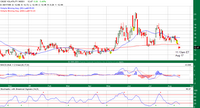Wendy's and Tim Hortons
Wendy's is completing the spin-off of Tim Hortons through a special stock dividend. This dividend behaves somewhat like a stock split -- for every share of WEN that you own on the date of record, you will get 1.3593 shares (or so) of THI on the pay date. Then on the ex-date, the value of WEN will decrease by the value of THI. From that point forward, the two are completely separate, publicly traded companies.
There are a few interesting details on how a special stock dividend like this works:
- The IRS has ruled (search for "Internal Revenue Service") that this special stock dividend is not a taxable event. It must be because the combined value of WEN and THI on the pay date is the same as WEN's value before the pay date. So it behaves like a traditional stock split.
- You can't own fractional shares, so you get cash for that part instead, and that cash is a taxable event. If you are owed fractional shares due to the dividend, Wendy's will aggregate your fractional shares with other shareholder's fractional shares, sell them on the open market (the taxable event), and distribute the cash proceeds proportionately.
- Between the record and pay dates, there are two markets for WEN shares.
- The regular-way market uses the same WEN ticker symbol. It represents the shares before the stock dividend is paid. If you sell WEN shares in the regular-way market, you also sell your right to the stock dividend to the buyer! This is different from the typical cash dividend. With cash dividends, the ex-date is before the record date, so selling between record and pay dates still entitles you to the cash dividend. But for a stock dividend, the ex-date is after the pay date, so you have to hold the stock at least through the pay date to get the dividend. For the WEN/THI stock dividend, the only purpose of the record date seems to be the set the payout ratio of how many THI shares need to be delivered to each share of WEN.
- The when-issued market uses the WENWI ticker symbol. It represents the shares as if the stock dividend had already been paid but actually hasn't yet. Buying WENWI shares does not entitle you to the stock dividend. Adding the "WI" suffix to the base ticker symbol seems to be the standard practice for listing when-issued shares.




